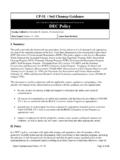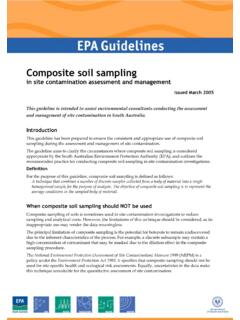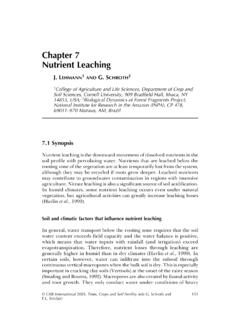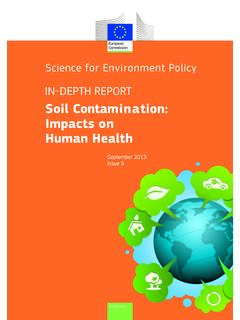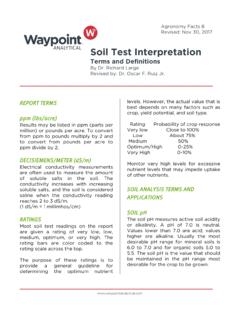Transcription of A GUIDE TO TESTING SOIL FOR HEAVY METALS
1 11A GUIDE TO TESTING soil FOR HEAVY METALS1 We also tested irrigation water and produce samples at many sites. Given the findings of our study, we do not feel that TESTING irrigation water repeatedly is necessary. Once we receive the produce results from the study, we will follow up with a GUIDE to TESTING produce if we feel it merits re- TESTING in the Safe Urban Harvests (SUH) study collected and tested soil1 samples from farms and gardens during the 2017 growing season to answer questions about risks of exposure to HEAVY METALS for urban farmers and gardeners in Baltimore and to pro-mote safe growing practices.
2 We have since received additional questions from participants about where, when, and how to test their soil in the future. We have compiled this GUIDE to help answer some of these questions. WHY SHOULD I TEST MY soil ?Most conventional soil tests measure the levels of essential and beneficial elements for plants ( , nitrogen, phospho-rus, potassium, calcium, copper, iron, magnesium, manga-nese, zinc). These fertility tests provide valuable information for gardeners interested in improving the health and qual-ity of their soil and produce. In contrast, the Safe Urban Harvests study measured the lev-els of HEAVY METALS that are harmful to human health (arse-nic, barium, cadmium, chromium, lead, and nickel) in the soil , water, and produce of urban farms and gardens in Baltimore.
3 HEAVY metal contamination tests provide valuable informa-tion about the presence of harmful METALS in soils and can help inform safer growing practices that limit contact with soils with high levels of METALS . WHERE CAN I HAVE MY soil TESTED?There are a variety of labs and soil tests to choose from to ac-commodate different budgets and preferences. Table 2 on page 5 contains information on these various factors to consid-er when choosing a TESTING service, including which labs test the same METALS that are harmful to human health as we tested in the Safe Urban Harvests study (arsenic, barium, cadmium, chromium, lead, and nickel).
4 22 HOW OFTEN SHOULD I TEST MY soil ?To our knowledge, human health-risk based recommendations for how often to test soil for HEAVY METALS do not exist. How-ever, some state Extension offices have recommendations for frequency of soil TESTING to measure fertility and conditions for optimal plant growth. University of Maryland Extension recom-mends nutrient TESTING at least every 3 Purdue University Extension recommends soil pH and nutrient TESTING every 3-5 The University of New Hampshire Extension4 and Ohio State University5 both recommend TESTING soil every 2-3 years to maintain optimal soil fertility. The University of Georgia Exten-sion recommends TESTING soil fertility every 1-2 To minimize the time spent collecting samples and costs, we recommend re- TESTING your soils for HEAVY METALS as often as you test them for fertility, about every three years.
5 However, we understand this can be cost prohibitive for some groups. Table 1 describes some factors that you may consider when deciding how often to test your soil for HEAVY 3 ,%20 Gardens%20and%20 Wildlife%20 Food%20 PlotsTable 1: Factors influencing how often you might choose to test your soilYou might feel comfortable TESTING your soil less frequently for HEAVY METALS if:You might want to test your soil more frequently for HEAVY METALS if:You have not significantly changed your growing is a history of HEAVY metal contamination on your garden/farm have not added new imported soil or amendments (including compost brought in from off-site) between have added new imported soil or amendments to your site (including compost brought in from off-site).
6 You don t have any concerns about potential contaminants from run-off or dust from nearby construction or believe your site has been contaminated by runoff or dust from nearby construction or SHOULD I COLLECT soil SAMPLES FOR TESTING ?Always make sure to follow the guidelines of your chosen soil - TESTING lab. The following general soil TESTING guidelines are based on the University of Maryland Extension s recommenda-tions for soil fertility TESTING and the Safe Urban Harvests soil TESTING for HEAVY METALS methods and can be followed to ensure the soil sample is taken correctly. Divide your garden into separate areas.
7 Try to pick areas that represent the variety of growing conditions and spaces in your garden. Use a spade or trowel to take a scoop from each area. In total, about 10-12 scoops should be collected. The samples should be taken at a depth of about 6 inches. You can combine the 10-12 samples in one clean container and mix together, or if your budget allows, you can send each separate scoop to the lab for TESTING for a more detailed analysis of your site. Remove any large debris like rocks, foreign objects, or plant material. Put the sample in the collection bag or envelope sent by the there is a particular area of concern in your farm or gar-den, you may want to take scoops of soil from only this area and send those off separately for TESTING .
8 For example, a gar-den bed next to the foundation of an old building might be at higher risk for contamination from lead paint, so you might want to test that bed separately. 44 WHICH TEST SHOULD I SELECT?The Safe Urban Harvests study used a digestion process called aqua regia which uses heat and two concentrated acids (nitric and hydrochloric acid) to extract METALS from the soil so they can be measured. This method uses very strong digestion acid for measuring the environmentally available total of all METALS in the soil . We chose to use this strong digestion because we believe it is more protective than other methods.
9 If you would like to compare future soil test results to those we sent you as part of the Safe Urban Harvests study, you should send your soil samples to a lab that uses a similar method, , EPA 3050, 3050B or 3051 (Table 2 on page 5). If you have additional questions about the information contained in this GUIDE , please contact: Safe Urban Harvests Study TeamJohns Hopkins Center for a Livable Future 111 Market Place, Suite 840, Baltimore, MD 21202 Keeve Nachman, Principal Investigator 410-223-1707 of Maryland Extension Baltimore City Neith Grace Little, Extension Educator-- Urban Agriculture 6615 Reisterstown Road, Suite 201, Baltimore, MD 21215 410-856-1850 ext.
10 123 urban-agriculture55 Table 2: soil TESTING agencies*Please note we have chosen to highlight the METALS tested with the Safe Urban Harvests study. In many cases, these tests in-clude additional metal name ArsenicBariumCadmiumChromiumLeadNickelCo stSoil test methodColorado State University soil , Water and Plant TESTING LaboratoryWaste Materials Sludges/Biosolids Call to inquire as prices changeExtractable (AB-DTPA)Cornell Nutrient Analysis Laboratory2021 HEAVY METALS and Trace Elements $ sampleEPA Acid Digestion Method 3050 Penn State Agricultural Analytical Services LabTotal Sorbed METALS Test II plus mercury $ sampleEPA method 3050B + 6010 Penn State Agricultural Analytical Services LabTotal Sorbed METALS Test $ sampleEPA method 3050B + 6010 Umass Amherst soil and Plant TESTING LaboratoryTotal Sorbed METALS Test $ sampleEPA method 3050B + 6010 University of Delaware soil TESTING ProgramB7 - HEAVY metal Screening Test $ sampleMehlich extraction screening testUniversity of Maine Analytical Lab
